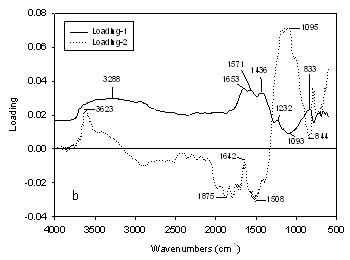| Author | Message | ||
Hongtu Xie (tonali) New member Username: tonali Post Number: 3 Registered: 2-2010 |
Dear Howard Mark and Jose Miguel Hernadez Hierro: Thanks for your help. Best regards. | ||
Howard Mark (hlmark) Senior Member Username: hlmark Post Number: 308 Registered: 9-2001 |
Hongtu - your previous message gave the impression that ALL your Principal Components had positive loadings at all wavelengths. Now that you are showing more than one, it is clear that only the first Principal Component has all loading being positive. The underlying cause of this type of behavior is that in fact, one aspect of the behavior is that the absorbance at all wavelengths increase and decrease simultaneously. This is typical of data measured on solid powders, where differences in the optical scattering of the light from sample to sample cause that sort of simultaneous increase/decrease. In fact, this effect can even be observed from different aliquots of the same sample. In addition to reading up on basic chemometrics, I also suggest that you read a good book on basic NIR; there are several available. Howard \o/ /_\ | ||
Hongtu Xie (tonali) New member Username: tonali Post Number: 2 Registered: 2-2010 |
 Thanks all I upoad the loading figure derived from soil spectra and the loading-1 is positive. It is different from other soil spectra studyies. So I'm not sure about it. we obtain the similar results by MATLAB, Unscramber, PLS-Toolbox softwares. | ||
Jose Miguel Hernadez Hierro (jmhhierro) Junior Member Username: jmhhierro Post Number: 8 Registered: 4-2008 |
Dear Tonali, principal components and latent variables are vectors but the first are obtained explaining the variations in the X matrix while the second are obtained taking to account the Y matrix too. Loadings are the cosine between the new vector and the original variables. If the cosine is positive the angles are between 0 and 90 grades then the "directions" are close to the direction of the new vector. Regards Jos� Miguel | ||
Howard Mark (hlmark) Senior Member Username: hlmark Post Number: 307 Registered: 9-2001 |
Hongtu - "Latent Variable" is a more general term than "Principal Components". In spectroscopy we can think of any multivariate construction as being a spectrum and while not strictly true is it sometimes convenient to think of them that way. Then a Latent Variable can be any "spectrum" that cannot be seen directly, but that can be separated out from actual measured spectra, and can be used to describe, or more to the point, to reconstruct the measured spectra. An example is the use of the spectra of the pure components of a set of mixtures to construct the spectra of the mixtures by adding them together, weighted (i.e., multiplied by) by their concentrations in the mixtures. In this sense, the spectra of the pure components constitute the "Latent Variables". Another common methods, although not usually thought of that way, would be a Fourier Transform; the sines and cosines could also be considered "latent variables" since they are not seen directly in the spectra. Principal Components are a set of latent variables that have a set of defined properties. The most important property is that for any set of data spectra, the first Principal Comnponent calculated from that set of spectra can approximate the data spectra better (that is with a smaller sum-squared error) than any other single function can. The first two Principal Components can approximate the data spectra better than any other two functions can. And so forth. Another property of Principal Components is that all components calculated from a set of data are mutually orthogonal. That means that if multipled together term-by-term and the products added together, the sum must be zero. That makes it impossible for more than one Principal Component in a set to have all loading values be positive (or negative). There are several possible causes for all Principal Components to appear positive: 1) A bug in the computer program. 2) The data set you're using is singular. 3) What you're calling "loadings" are actually something else, and the terminology you're using is incorrect. A good starting point for understanding Principal Components is a good book on elementary Chemometrics; one such book is Richard Kramer's "Chemometric Techniques in Quantitative Analysis", and there are many others. But an explanation such as the one I just gave you will make a lot more sense when you're more familiar with the basics. Howard \o/ /_\ | ||
Hongtu (tonali) New member Username: tonali Post Number: 1 Registered: 2-2010 |
Dear all: I met to questions when studying the Multivariat data analysis 1)What's the difference between "latent variables" and "principal component" 2)In PCA analysis, what's the meaning of negetive and positive loadings. The loadings of my results are all more than zero. Thanks |